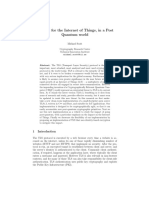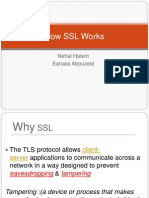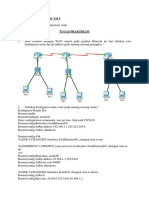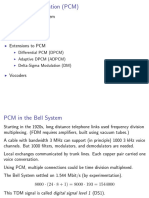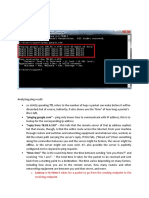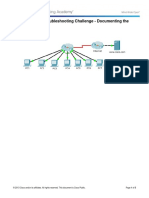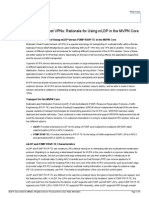Chapter 3
Secure links
We now know how to reliably send bytes from one process to an-
other over the network. The problem is these bytes are sent in the
clear, and any middle-man can intercept our communication. To
protect against that, we can use the Transport Layer Security1 (TLS)
protocol. TLS runs on top of TCP and encrypts the communica-
tion channel so that application layer protocols, like HTTP, can
leverage it to communicate securely. In a nutshell, TLS provides
encryption, authentication, and integrity.
3.1 Encryption
Encryption guarantees that the data transmitted between a client
and a server is obfuscated and can only be read by the communi-
cating processes.
When the TLS connection is first opened, the client and the server
negotiate a shared encryption secret using asymmetric encryption.
Both parties generate a key-pair consisting of a private and public
part. The processes are then able to create a shared secret by ex-
changing their public keys. This is possible thanks to some math-
1
https://en.wikipedia.org/wiki/Transport_Layer_Security
�CHAPTER 3. SECURE LINKS 31
ematical properties2 of the key-pairs. The beauty of this approach
is that the shared secret is never communicated over the wire.
Although asymmetric encryption is slow and expensive, it’s only
used to create the shared encryption key. After that, symmetric en-
cryption is used, which is fast and cheap. The shared key is peri-
odically renegotiated to minimize the amount of data that can be
deciphered if the shared key is broken.
Encrypting in-flight data has a CPU penalty, but it’s negligible
since modern processors actually come with cryptographic instruc-
tions. Unless you have a very good reason, you should use TLS
for all communications, even those that are not going through the
public Internet.
3.2 Authentication
Although we have a way to obfuscate data transmitted across the
wire, the client still needs to authenticate the server to verify it’s
who it claims to be. Similarly, the server might want to authenti-
cate the identity of the client.
TLS implements authentication using digital signatures based on
asymmetric cryptography. The server generates a key-pair with a
private and a public key, and shares its public key with the client.
When the server sends a message to the client, it signs it with its
private key. The client uses the public key of the server to verify
that the digital signature was actually signed with the private key.
This is possible thanks to mathematical properties3 of the key-pair.
The problem with this naive approach is that the client has no idea
whether the public key shared by the server is authentic, so we
have certificates to prove the ownership of a public key for a spe-
cific entity. A certificate includes information about the owning
entity, expiration date, public key, and a digital signature of the
third-party entity that issued the certificate. The certificate’s issu-
2
https://blog.cloudflare.com/a-relatively-easy-to-understand-primer-on-
elliptic-curve-cryptography/
3
https://en.wikipedia.org/wiki/Digital_signature
�CHAPTER 3. SECURE LINKS 32
ing entity is called a certificate authority (CA), which is also repre-
sented with a certificate. This creates a chain of certificates that
ends with a certificate issued by a root CA, as shown in Figure 3.1,
which self-signs its certificate.
For a TLS certificate to be trusted by a device, the certificate, or one
of its ancestors, must be present in the trusted store of the client.
Trusted root CA’s, such as Let’s Encrypt4 , are typically included
in the client’s trusted store by default by the operating system ven-
dor.
Figure 3.1: A certificate chain ends with a self-signed certificate
issued by a root CA.
When a TLS connection is opened, the server sends the full cer-
tificate chain to the client, starting with the server’s certificate and
ending with the root CA. The client verifies the server’s certificate
4
https://letsencrypt.org/
�CHAPTER 3. SECURE LINKS 33
by scanning the certificate chain until a certificate is found that it
trusts. Then the certificates are verified in the reverse order from
that point in the chain. The verification checks several things, like
the certificate’s expiration date and whether the digital signature
was actually signed by the issuing CA. If the verification reaches
the last certificate in the path without errors, the path is verified,
and the server is authenticated.
One of the most common mistakes when using TLS is letting a cer-
tificate expire. When that happens, the client won’t be able to ver-
ify the server’s identity, and opening a connection to the remote
process will fail. This can bring an entire service down as clients
are no longer able to connect with it. Automation to monitor and
auto-renew certificates close to expiration is well worth the invest-
ment.
3.3 Integrity
Even if the data is obfuscated, a middle man could still tamper
with it; for example, random bits within the messages could be
swapped. To protect against tampering, TLS verifies the integrity
of the data by calculating a message digest. A secure hash function
is used to create a message authentication code5 (HMAC). When a
process receives a message, it recomputes the digest of the message
and checks whether it matches the digest included in the message.
If not, then the message has either been corrupted during trans-
mission or has been tampered with. In this case, the message is
dropped.
The TLS HMAC protects against data corruption as well, not just
tampering. You might be wondering how data can be corrupted if
TCP is supposed to guarantee its integrity. While TCP does use a
checksum to protect against data corruption, it’s not 100% reliable6
because it fails to detect errors for roughly 1 in 16 million to 10
billion packets. With packets of 1KB, this can happen every 16 GB
to 10 TB transmitted.
5
https://en.wikipedia.org/wiki/HMAC
6
https://dl.acm.org/doi/10.1145/347057.347561
�CHAPTER 3. SECURE LINKS 34
3.4 Handshake
When a new TLS connection is established, a handshake between
the client and server occurs during which:
1. The parties agree on the cipher suite to use. A cipher suite
specifies the different algorithms that the client and the
server intend to use to create a secure channel, like the:
• key exchange algorithm used to generate shared
secrets;
• signature algorithm used to sign certificates;
• symmetric encryption algorithm used to encrypt the ap-
plication data;
• HMAC algorithm used to guarantee the integrity and
authenticity of the application data.
2. The parties use the negotiated key exchange algorithm to cre-
ate a shared secret. The shared secret is used by the chosen
symmetric encryption algorithm to encrypt the communica-
tion of the secure channel going forwards.
3. The client verifies the certificate provided by the server. The
verification process confirms that the server is who it says it
is. If the verification is successful, the client can start send-
ing encrypted application data to the server. The server can
optionally also verify the client certificate if one is available.
These operations don’t necessarily happen in this order as modern
implementations use several optimizations to reduce round trips.
The handshake typically requires 2 round trips with TLS 1.2 and
just one with TLS 1.37 . The bottom line is creating a new connec-
tion is expensive; yet another reason to put your servers geograph-
ically closer to the clients and reuse connections when possible.
7
https://tools.ietf.org/html/rfc8446








